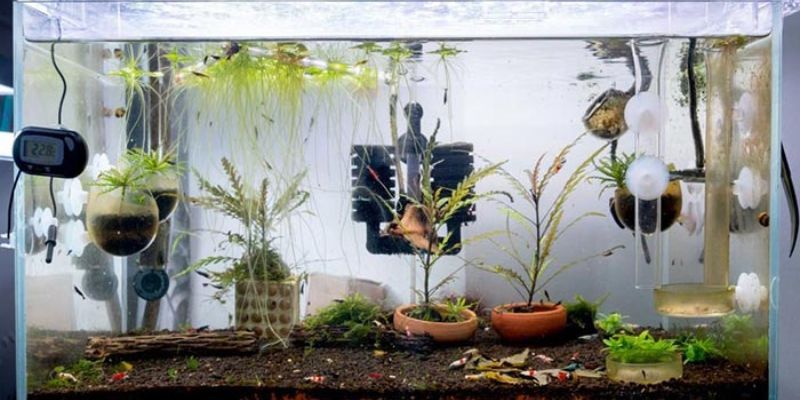Welcome to the complete 2023 guide to cycling a fish tank. Understanding the cycle process is essential for keeping a healthy aquatic habitat for your fish, whether you’re an experienced aquarium enthusiast or a novice setting up your first fish tank. “How to Cycle a Fish Tank in 2023?” step by step, the significance of cultivating beneficial bacteria, and practical advice will all be covered in this post.
How to Cycle a Fish Tank in 2023?
Choosing the Correct Tank
- Depending on the kind and number of fish you intend to maintain, choose a tank that is the right size.
- Think about things like space availability, upkeep requirements, and compatibility with the fish species you’ve picked.
- Choose a tank size that permits sufficient swimming room and enough filtration.
Getting the Crucial Gear Together
- Invest in a top-notch filter system to ensure effective toxin removal and water circulation.
- Get a dependable heater to keep your fish’s water at the right temperature.
- Depending on the requirements of your particular fish species, you might want to add a thermometer, an air pump, and a lighting system.
Getting the Tank Ready
- Use warm water to scrub the tank and any equipment thoroughly. Avoid using soap or detergents as they can be harmful to fish.
- Rinse gravel or substrate under running water to remove any debris or dust.
- Decorate the tank with aquatic plants, rocks, or ornaments to provide hiding spots and create a natural environment for the fish.
Adding Water and Conditioner
- Fill the tank with dechlorinated water at the appropriate temperature for your fish species.
- Treat the water with a reliable water conditioner to remove chlorine, chloramine, and heavy metals that can harm the fish.
Introducing Beneficial Bacteria
- Kick-start the cycling process by adding beneficial bacteria to the tank.
- You can use commercially available bacterial supplements or introduce live bacteria from an established aquarium.
- Beneficial bacteria help convert harmful ammonia produced by fish waste into nitrite and eventually into less toxic nitrate.
Testing Water Parameters
- Regularly monitor the water parameters during the cycling process to ensure they are within the acceptable range.
- Test the levels of ammonia, nitrite, nitrate, pH, and temperature using reliable aquarium test kits.
- Aim for ammonia and nitrite levels to reach zero, indicating the establishment of a stable biological filter.
Feeding the Cycling Process
- Add a source of ammonia to feed the growing colony of beneficial bacteria.
- You can use fish food, ammonium chloride, or pure ammonia drops to simulate the presence of fish waste.
- Follow dosage instructions carefully to avoid overloading the system.
Patience and Observation
- A fish tank must be cycled, which usually takes a few weeks to a month or more.
- To guarantee that your fish are in a stable and healthy environment, be patient and avoid hurrying the procedure.
- To maintain ideal conditions, frequently check the water parameters and make any required modifications.
FAQs on Fish Tank Cycling
-
How long does it take a fish tank to cycle?
Although the cycling process can last for a variety of time frames, it typically lasts 4-6 weeks. It relies on elements including tank size, fish load, and biological filter effectiveness.
-
Is it possible to cycle a tank that contains fish?
It is not advised to cycle a fish tank that already contains fish since the procedure’ high ammonia and nitrite concentrations may endanger the fish. . Instead, consider fishless cycling methods.
-
What is the role of beneficial bacteria in the cycling process?
Beneficial bacteria convert toxic ammonia into nitrite and then into nitrate, which is less harmful to fish. They establish a stable biological filter that helps maintain water quality.
-
How can I speed up the cycling process?
To speed up the cycling process, you can use bacterial supplements specifically designed for fish tank cycling. These supplements introduce a concentrated amount of beneficial bacteria into the tank.
-
Can I add fish immediately after the cycling process is complete?
It is still advisable to add fish gradually even after the cycling process is complete. This allows the biological filter to adjust to the increased fish load and prevents ammonia spikes.
-
How often should I test the water parameters during cycling?
It is recommended to test the water parameters every few days during the cycling process to monitor the progress. Once the tank is cycled, regular testing can be done on a weekly or bi-weekly basis.
Conclusion
Cycling a fish tank is an essential process to establish a healthy and stable aquatic environment for your fish. By following the steps outlined in this guide, you can ensure the successful cycling of your fish tank in the year 2023.
Remember to be patient, monitor water parameters regularly, and provide the necessary care for your fish. Happy fishkeeping!


purchase misoprostol online cheap – buy generic diltiazem 180mg diltiazem canada